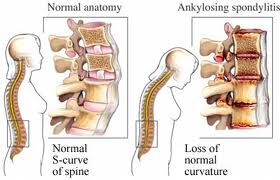
What is ankylosing spondylitis?
Ankylosing spondylitis is a chronic and progressive form of inflammatory arthritis. Ankylosing spondylitis affects the spine and sacroiliac joints. The symptoms start appearing commonly in the second and third decade of life.
Ankylosing spondylitis is also known as Bekhterev’s disease, Bekhterev syndrome or Marie-Strumpell disease. It is inherited genetically.
Other than affecting the joints ankylosing spondylitis may also affect organs of the body such as heart, lungs, and eyes and in some cases kidney. Hence it is also called a systemic disease.
The joint gets inflamed at the initial stage and then it is followed by stiffness that results in fusion of the spine. The condition is often called bamboo spine, as the spine gets stiff like a bamboo. The mobility of the spine is lost.
Ankylosing is taken from a Greek word ankylos, which means stiffening of a joint. Spondylos means vertebra. Spondylitis is the inflammation of one or more vertebrae.
This condition also affects children and then it is referred as Juvenile Ankylosing Spondylitis.
What are the causes of ankylosing spondylitis?
The cause of ankylosing spondylitis is unknown. It is considered to be an autoimmune disease. Generally, people suffering from ankylosing spondylitis have gene called HLA-B27.
It can be compared with other diseases like psoriatic arthritis, reactive arthritis (formerly called Reiter’s disease) and arthritis associated with Crohn’s disease & ulcerative colitis.
Who are more prone to ankylosing spondylitis?
Males are more prone to ankylosing spondylitis as compared to females and those who have family history of ankylosing spondylitis are also affected.
What are the symptoms of ankylosing spondylitis?
-Pain in back, buttocks.
-Morning stiffness.
-Weight loss.
-Fatigue.
-Reduced mobility.
-rigidity in the spine while bending.
-Severe inflammation of the lumbar spine and sacroiliac joints can develop a complete bony fusion of the spine with low back and buttock pain.
-pain and stiffness in the back of the heel called Achilles Tendinitis, especially while walking upstairs. Inflammation of the tissues on the bottom of the foot, plantar fasciitis, occurs more frequently in people with ankylosing spondylitis.
-In the advanced stage when the whole spine is involved patient notices stiffness and inflexibility resulting in chronic stooping and restricted expansion of spine.
What are the Signs of ankylosing spondylitis?
Following are the signs of ankylosing spondylitis:
-Tenderness at the sacroiliac joint.
-Cervical, thoracic spines become tender.
-Restricted movement.
-The patient cannot erect spine.
-Sitting, walking with a flexed spine.
-The complete rigidity of spine & involved joint.
-Kyphosis (curve in the spine).
What happens if ankylosing spondylitis is not treated?
If ankylosing spondylitis left untreated than chronic inflammation leads the vertebrae to fuse together. This fusion of vertebrae causes restricted movement while bending, twisting, or turning and results in frequent back aches.
How to diagnose ankylosing spondylitis?
-Blood Test
-CT scan.
-MRI to assess early cartilage abnormalities and bone marrow edema.
What are the complications of ankylosing spondylitis?
-Aortic incompetence.
-Recurrent chest infection.
-Inflammation of the iris may occur.
-kidney failure may occur because of the deposition of proteins in the kidneys called amyloids.
Homeopathic treatment for ankylosing spondylitis?
Aesculus hippocastanum
Calcarea phos
Silica
Rhus tox
Bryonia
Colchicum
guaiacum
Is There Any Effect Of Changing Lifestyle? ?
-Physiotherapy.
-Try to maintain right posture while sitting, standing and sleeping.
-Exercise increases flexibility and reduces stiffness.
-Consume a well-balanced, highly nutritious diet.
-Hot fermentation on affected part helps in relieving pain.
-Quit smoking.
Diet:
-Low starch diet
-Diet rich in anti-inflammatory essential fatty acid
-Avoid fatty and fried foods, pastries, and chocolate.
-Foods rich in silicon include wholegrain cereals, hard nuts, seeds and apple
-Foods high in Vitamin C maintains healthy connective tissue.
-Avoid acid forming food.
-Potato, tomato, aubergine, chili, and peppers can aggravate joint inflammation.
-Eat plenty of vegetables, fruits, and whole-grain products.
-Drink 8-10 glasses of water a day
-Spend an hour of a day in direct daylight or add dietary supplementation of vitamin D
-Fresh, natural yogurt is a good source of acidophilus bacteria that maintain a healthy bowel and digestive system.

 If you are unsatisfied with our treatment and do not want to continue the medicines you can ask for refund within 24 hours of making the payment.
If you are unsatisfied with our treatment and do not want to continue the medicines you can ask for refund within 24 hours of making the payment.